Thursday, December 15, 2005
Comments from the Guest Book
Welcome!
Please take a moment to sign our guestbook.
Les us know where you are visiting from and add any comments you wish.
If you would like to be notified about future art events, please leave contact information.
Thank you for visiting Art Site 2005!
Bainbridge Island Public Art Committee
Administered by
Bainbridge Island Arts & Humanities Council
3 August
Mileth Klein
Scarlet Klein
Brad Klein
Nita Klein
7 August
Dennis Brandt
Sandy DiLena, Toronto, Ontario
Kathleen McCabe, Toronto, Canada
Wayne & Rebecca Madison
Steve, Charlotte Humphry
Dennis Coffey
Ruth Courtland,
LA, CA
Jim Holden, Suquamish, WA
WOW – TOO KOOL
M.L. Ott & G.S. Howarth, Bainbridge Island
Sandy Neale
Shiers & guests
Susan Jackson & Sister
P.C. Harper
Absolutely Terrific! Thanks.
9 August
James James Patterson Patterson
Viki Walaskay
Forrest & Clayton Gurowitz
Gray Yockman
Hawk
11 August
Elizabeth Blake
Thank you.
Dan & Sonya Carvin
Peace to all
Christ Davenport
Ken Ragsdale
Ruth
Maia
Esther Parvin
John Young
Adam Rabinowitz
13 August
Shinto Imai – Bainbridge-Seattle
Great site, great curiosity & some very good work to transform & make aware
S. Main, Connecticut
My compliments to the blackberry artist. Where can I get more of her work?
Denise Johnson, Post Falls, ID
Fun, great for exploring
John & Sue Anderson, Bainbridge Island, WA
14 August
Dave & Gail Christensen, Bainbridge
Mary Ann & Don Christensen, Ketchikan
Joan Hutchinson & Curtis Hughes, Bainbridge Island
Lee E. Fickle, Bainbridge Island
Sandra Ramsden, Brisbane, Australia
A different experience
Jack & Nan Fleming, Poulsbo, WA
Fun
Marianne Hanson, Seattle
Brenda Hughes, Seattle
Linda Younker with Sally Robison, Bainbridge Island
21 August
Keiko Shimada, Japan
Michael Sharp & Diane Francis, Bainbridge Island
Pam & Jack Johnson, Bainbridge Island
Adele Berg-Layton, Bainbridge Island
K. MacDonald, San Francisco, CA
Jeanne, Harry & Miles Thomas, Seattle, WA
Karen Cornell, Bainbridge Island
Lanara Stone, Bainbridge Island
Steve & Marilyn Gray, Beaverton, OR
Garbage – who are you kidding?
What a bunch of crap – is there anything you won’t classify as “art”? But to be fair, it’s great for a laugh…
Val Torrens & Dave Russo, Poulsbo, WA
Everyone’s a critic – too bad. Good idea and great way to spend some time. Thanks!
28 August
Martha Bien, Bainbridge Island
John Robbins, Naperville, IL
#3 Best City, Voted by Money Magazine!
Oh, the effort everyone “put in” to make this trail interesting – and a learning experience too. Saw my first English laurel and loved the “lid display”. Thank you! A wonderful kind of art… that tempts, teases, and makes one think and ask questions. Thank everyone who played a part. JR
Thank you.
Richard Thurston
Daniela Siegenthaler
29 August
Karen A. Wilken, Bainbridge Island & Fairbanks, AK
O’Reilly Fam, Highland Drive, Missoula, MT
4 Teachers from T.T. Minor School in Seattle on retreat @ Idlewood
30 August
Kathryn & Laughanne MacDonald
Thanks!
#7 Wow! Swept us away…Timmie
1 September
Liked the foundation and view point – Rick
Loved the art AND the blackberries. We don’t have those in Arizona. Mimi, Yuma, AZ
3 September
Joyce Rudolph
Laurie Anting
Micki Kent
Willa Foster
Thank you! Priscilla & Helene
4 September
Reynolds Family – Cool Stuff
Nigel, London – I felt like I was at a famous museum.
Colleen Ziakin – Thanks!
Found new inspiration! Marty & Jill Stone
5 September
Thanks for doing this. Good luck converting this to a park. Dan Kaylor, Seattle, WA
The Strathdee Family, Bainbridge Island – Great Display!
Margot Jacobs, Bainbridge Island
Interesting stuff! Somewhat challenging for old people! Couldn’t find 8-9-10-11. Followed a trail after 6, no flags, so decided wrong way. Did go under a beautiful tunnel of trees but came to a small gully which I decided not to leap across. Yes, I had the map. I will go see 10 & 11.
John Materner, Bainbridge Island
Interesting interpretation of the site past, present & future.
9 September
Glad to get to Bainbridge while this art is still up – we’ve heard about all the work that has gone into the effort from Jenny Tolefson and wanted to check out Kristin’ work – my fooks who now live here walked the whole site and enjoyed feeling how the different artists expressed themselves in this special place. Kristin – I wanted to crawl into your art! What a great space you created – I was a fort building child! Thanks! Sonja, Svend, Edie Hartmann & Steve Prather
Thanks again! Always happy to see and support the Arts! Kay & Charlie Watkins, Bainbridge Island
10 September
Thank you! Kim Sather
Great Park! Steve Seifried, age 10
13 September
What a birthday present to myself by visiting Collocation! Thank you! Bruce Wallace, Winslow
Theresa Connolly, Seattle
Make this permanent! Phyllis Cairns, Bainbridge Island
Will & Chappe Langemack, Bainbridge Island
Allegra Archer
It was very fun and cool.
21 September
What a nice way to spend an hour on the last day of summer – first day of fall. The view of Seattle from the platform was stunning!!! It seems obvious to me who girdled those beautiful trees. Sondra Kay, Bainbridge – Clean up this site!!!
Wednesday, November 02, 2005
Perri Lynch's FloatingDatum:FixedGrid
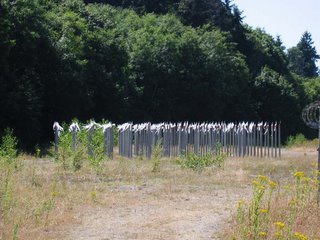

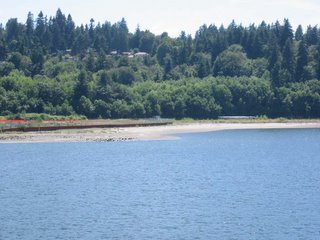
The beach plateau forms an arc to the west of the EPA site, a gravelly open space between trees and sea. The vortex sits farthest back from the beach and catches the wind when it blows to the West from the mouth of Eagle Harbor. Birds also nest in the gravel, and I have found a bare egg resting in a tuft of grass here.
Perri Lynch gravitated toward this site immediately, and her proposal for work reflected this connection. A grid of poles would be installed between land and water, fitted with wind indicators at the tops. As she envisioned it, "The wind indicators will pattern the directional flow and velocity of air currents. In very high winds, the piece will emit a low humming sound. The grid structure references the human compulsion to map and monitor while the sensors remind us to look and feel. This installation will create an interstitial relationship between the natural rhythms of Pritchard Park and mankind’s systematic tendencies towards land use. As a reclaimed Superfund area, I can’t imagine a more poignant place for this work."
This piece was unique to the site in its scale, its complexity of installation, and the life it took on in the larger context of the site. It was visible from a distance across the water from the ferry, from many angles of pedestrian approach, and was a piece to maneuver around and through. One of my favorite views was from the adjacent beach. From this slightly lower angle, you saw the poles rise out of the haze of blackberries and brush, capped with the flowing field of flags.
FloatingDatum:FixedGrid plays out the tension of the place on multiple levels, that theme that I found sustained throughout the vast variety of work in this show. We see deliberate human handiwork interface with the will of the wind, the imposition of industrial materials and processes on a fragile and resilient site, the calm poetry of the poles and flags as the work pins down its corner of earth. This work generates commentary and silence.
Perri's own words about her piece: "My work investigates the relationship between human perception and sense of place. Navigation, intuition, and physical proximity are key components of these investigations. I am drawn to landmarks such as billboards, survey stations, and cairns that influence our sense of direction and lead us onward. Sense of place does not exist outside of ourselves. It shifts relative to our bodies, our memories, and what we choose to pay attention to. I hope to draw attention to details in our surroundings that are often overlooked or unheard. With more sensitivity towards our environments, we all may derive a deeper sense of place.
FloatingDatum:FixedGrid examines ways in which our Cartesian sensibilities superimpose order on the world and nature’s assertion in response. The grid references mankind’s compulsion to map and monitor. Wind sensors remind us to look and feel. A regimented, axial construct is staged in forced harmony with the natural rhythms of Pritchard Park."
Amanda Sturgeon's Rock Wall
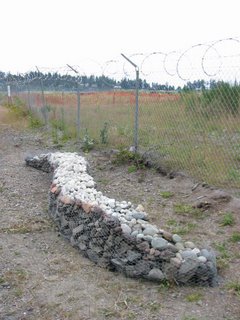
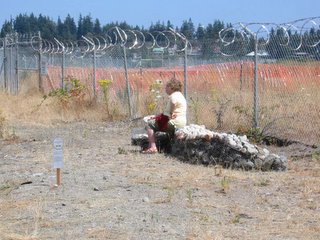 The Pritchard Park site has many physical attributes that make it a phenomenal and unique place on Bainbridge Island. The hillside woven with trails and foliage wraps the upper edge of a stretch of beachy waterfront rarely found in the Puget Sound. Interestingly, the terrain is partially imported, a result of the capping of the former creosote facility. And at the present, both coexist in a primary way: the sandy shoreline is flanked by a chain link fence wound with razor wire to enclose the EPA monitoring site.
The Pritchard Park site has many physical attributes that make it a phenomenal and unique place on Bainbridge Island. The hillside woven with trails and foliage wraps the upper edge of a stretch of beachy waterfront rarely found in the Puget Sound. Interestingly, the terrain is partially imported, a result of the capping of the former creosote facility. And at the present, both coexist in a primary way: the sandy shoreline is flanked by a chain link fence wound with razor wire to enclose the EPA monitoring site.It is this edge and demarcation that Amanda Sturgeon explores with her artwork. That she is an architect passionate about sustainability and living lightly on the earth is pertinent here: her rock wall comes out of and returns to the earth. We see emergence and disappearance, light and shadow, retention and fluidity. The rocks in the piece were gathered from the surrounding site and captured within a wireframe cage, situated parallel to the chain link fence. Two walls, two forms.
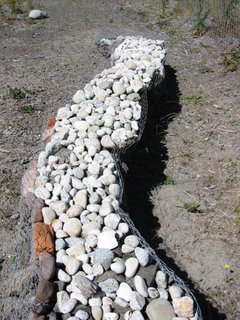
Hers is a quiet piece on the first reading: a sinuous gesture of an earthworked line. But there is also subtext: the gradated color of the rock wall from the dark base to the light top suggest earth's strata on one hand, and the process of interring the creosote pollution that has laid beneath this site on another. And the question of the wall's strength provokes as well, for it is clearly an inviting human-scale piece for sitting, but over time the wall sagged and morphed under its own weight.
Amanda writes: "I have created a natural stone wall adjacent to the chain link fence of the EPA site to juxtapose against the man-made steel wall that contains the creosote pollution. Formed within a chicken wire framework, the wall is undulating and contained at the same time.
The wall will symbolize the future of the park, curving, undulating and embracing as it emerges from the now clean ground. The wall expresses the natural beauty of the site and invites interaction by providing a suggestion of protection and shelter. It’s presence alongside the steel wall and barbed wire fence will offer contemplation of the site’s polluted history."
Tuesday, November 01, 2005
Polly Purvis' Ruins & Light
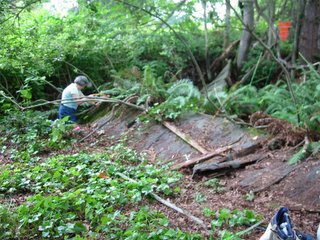
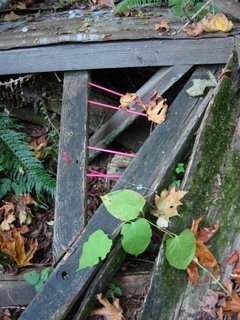
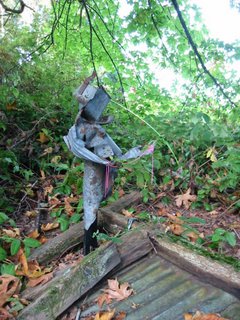
When I first saw Polly's work, I was struck by the fluidity with which she moves between media. She works primarily in photography and sculptural metalwork, bridging both with compelling imagery of figures and gestures.
At the point when she chose the derelict shed site for her installation, I saw how this interest in portraying human evidence dovetailed with her affinity for the aesthetic of archaeology. The work takes place at a portion of the park at which people worked and lived. A metal clad shed has collapsed in upon itself and creates a shallow basin flanked by wooden structures that suggest a clothesline could have stood to one side. Walking the trail a bit further, the other side of the clothesline stands above a neat pile of composite roofing shingle scraps.
With Polly's installation, the outlines of the space and its contours are revealed through careful cleaning and deliberate mark-making. The bones of the building surface with her removal of composted leaves and trash. Neon green, yellow and pink colored translucent plexiglas rods sprout from the ruined shed, drawing in the ambient light and luring our viewing eye along the walk toward the roofing shingles. Portions of the siding have been reconfigured into a graceful female form at one corner of the site. Pink plexiglas sheet and rod accent existing architectural details: a series of rungs, the triangular span of the clothesline support. And in the pile of roofing material we are given a glimpse into the possibility of the former inhabitants: photographs of dancing ghosts are tucked shyly into the mound. Shadows of human interaction with place abound in this work.
Polly's statement reads: "My sculptural constructions are inspired by human metaphor and my ongoing engagement with shadow and light. Themes of culture and history, ecology and memory are present in my work, as is a strong connection to landscape and the human figure.
Combining fabricated and natural materials with my photographs is at the core of my constructions. The transformation resulting from this interplay of silver emulsion and chemistry of photography, with metal and translucent materials is magical alchemy. My goal is to convey the spirit and essence of my subjects. They become after all, a celebration of the creative act.
Two sculptures rise out of the worker cottage ruins on the Park’s upper trail; both works incorporate artifacts found at the site with contemporary, ‘manufactured’ materials, drawing attention to the contrast of natural and fabricated, past and present."
Monday, October 31, 2005
Kristin Tollefson's Bliss
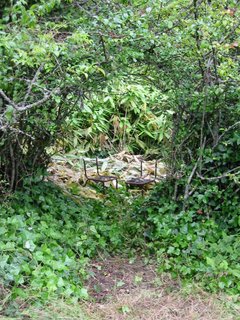

Emerging from the laurel grove, one finds oneself in a grove of another sort. Bamboo sprouts crowd up the hill in a thicket of strong stalks. Along the edge of the trail to the right is a natural quince bower, created by two lichen-encrusted specimens that have grown together in a knot of branches. Past the bower is a natural room skirted on the back and sides by the aforementioned bamboo, and carpeted by ivy.
I was drawn to this space very early on in the process of looking at the site, and for many reasons considered it to be too precious, or entirely complete without my interference. And all the same, I kept returning and questioning my draw to the place. In the end, I realize I wanted to make the vastness of the site smaller and more intimate, that I wanted to reference my personal relationship with the place which includes making a special hideaway for my kids, and to call into mind the historical fact that there was a valid domestic aspect to what is now seen primarily as a derelict industrial zone.
The chair frames were salvaged from under the laurel grove next door, and woven with raw steel wire. Black wooden beads punctuate the back rest and mimic the blackened quince that I discovered beneath the ivy and propped in the bower.
"My work derives its form from the organic and constructed worlds of botany and personal adornment. Utilizing traditional fiber techniques of stitching and weaving, I build my work out of metal wire and surplus, cast-off or industrial materials; I relish the tension inherent in creating beautiful, precious objects out of ordinary components. Inspiration for my forms is drawn from sources as wide-ranging as botanical illustration, folk art, fractals, and food preservation. Simultaneously scientific and poetic, these sculptures often assemble multiple simple elements into complex wholes, addressing themes of generative and transformative processes, the value of production and attention to detail, and the dialogue between interior and exterior space.
Bliss is a space that engages the domestic and the dream. It is a place into which we retreat. It is of this earth, but not of this world."
Ruth Marie Tomlinson's Beauty & Desire

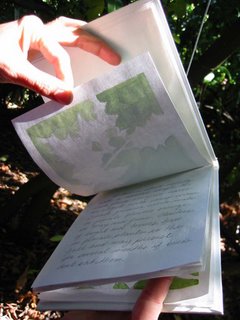

After the sharp turn up toward the woods from the edge of the ravine, the end of an old homesite becomes evident: bottles, the inside drum of a washer, and a homemade concrete threshold printed with hands of varying sizes were left here. Plants also indicate previous domestic life, and the 20 foot hight sprawling laurel marks the entry to Ruth Marie Tomlinson's piece.
Under the shady green canopy are books and specimen envelopes that chronicle several of the non-native plant species introduced to this site, including holly, butterfly bush, laurel and bamboo. The books hold anecdotal and scientific information about the plants, while the specimen envelopes hold a sample leaf backed by paper with the word "desire" or "beauty" in delicate script.
About her work in general Ruth Marie writes, "I have come to view nature as environment, including all the spaces and systems I inhabit and because I am part of these systems, I too, am nature. It has been a gentle but powerful shift from reverence for what is outside and separate, to an acknowledgement of my role within the system. I no longer look at nature as exotic; rather I see it as everyday. It is the grass pushing through my sidewalk and it is the sidewalk and it is the person who put the sidewalk there. It is the goods I buy, the politics I set into motion, as well as the sun raising over the Cascades and setting in the Olympics. This changing view of nature has inspired my interest in a marriage of industrial or man-made materials with forms derived from plants, animals, geology and the elements. It has also driven my interest in making art that creates environment and places the viewer as subject in that work, establishing an environment that revels in ambiguities and complexities of meaning / experience."
Regarding installation of UnderStory, she wrote the following: "Beneath this overgrown laurel hedge, remnant of someone’s careful yard, hangs a collection of preserved plant specimens, all gathered from plants imposed at Pritchard Park. These specimens tell a story of desire and conquest. Hanging books hold field notes documenting the current state of five imposed plant species. Each is a beautifully domestic plant, the desire of a family home, but potentially ruinous to the native environment. The books themselves await ruin, exposed to the elements. This work explores a blurred line between nature and culture. Pritchard Park is full of this ambiguity, the landscape rich with evidence of how much we are part of nature and yet deny our role within a symbiotic system."
Michelle Arab's Epiphyte



As you continue on the path, you pass a stretch of uninhabited space where no artists chose to place work. It skirts along the top of the ridge that drops steeply on one side toward the water, and heads gently up through heavy brush on the other side. Michelle had spoken to me about being drawn into the site because of its contours: she gravitated toward the ravine, down to the low spots that were nested at the crook of the cliff that abutted the beach.
Her piece at the big leaf maple creates its own kind of hollow in spite of its location at the crest of the steep hill, and because of her choice of material and treatment. The cluster of trunks has been wrapped in twine, methodically and in a linear pattern. The upright of the trees creates ribs for an oversized basket, of which the twine forms the weft. One space between two trunks has been left open, and viewers could enter the piece.
I was struck by the play of light on this piece -- how sun penetrated or reflected off the surface of the sometimes taut, then slackening line.
Michelle's own words: "My work investigates the relationship between art, landscape and architecture by creating conceptually driven, site specific pieces that reveal latent histories and stories.
Epiphyte
Supported by Big Leaf Maple trunks, the wrapping cotton twine will transform over the course of the three-month exhibit as the twine absorbs moisture. The changes in the environment will cause the initially taut lines to relax and break down the twine screen."
Thursday, October 27, 2005
Dan Linz' Monolith



Continuing on the trail through the eastern portion of Pritchard Park, you cross between the posts of an old barbed wire fence pinned to the edge of the bluff overlooking the EPA site. Just past the jog in the path, Dan Linz' piece is tucked on this crest, its imposing weight suspended improbably from a tree. It is a huge and dominating piece, and it is easily subsumed into its surroundings. If you aren't looking, you will miss it.
Dan's work embodies the buzz of contradictions within this place that I wanted to unveil through this show. His piece could hang anywhere, and yet it is quintessentially about and from this site. It is framed in a rectangular box, and because of that it is incongruous here, in this mass of undergrowth. But it is seamless as well: the box repeats the straight lines of the fenceposts and creosoted poles that dot the landscape, and the box form holds a collection of specimens from the site. Wound on the left side is a length of barbed wire cut from the adjacent fence, tacked to the base is corrugated iron roofing from a fallen shed, and collected across the face are other artifacts: a deer skull, gravel shiny black with the reference to creosote, an abandoned gasoline can and an old toy loader are some.
His gift is distilling the sense of discovery one encounters in this environment at the site. Darkness and beauty and mystery and sickness and hope intermingle here. He collects and displays with interest and lack of judgment, he witnesses and speaks through his work.
He writes, "For me art is like being lost without a sense of destination. Never quite sure whether I’ve gone too far, or not quite far enough. Fumbling in the dark for that map, that feeling of found. Its less about where you’re going and more about realizing that moment where you’re at.
It is my intention to create a piece that encapsulates not the similarities but the small disparities that make the site at Pritchard Park almost human. The history gone and grown over that continues to affect both the landscape of the future and the future of the landscape."
Sunday, September 11, 2005
Publicity in Seattle Times
This article was printed in the Friday, September 9, 2005 Ticket section of the Seattle Times and can be found online at http://archives.seattletimes.nwsource.com/cgi-bin/texis.cgi/web/vortex/display?slug=visarts09&date=20050909&query=collocation
A Bainbridge park as archaeological tour
Special to the Seattle Times
A wedge of Scotch broom that Gregory Glynn has cut by hand lies in the middle of a swath where he has cleared, then gathered and compressed the invasive plant. Situated in a clearing with spectacular views, Glynn's "Foundation" is wavy and organic at the top where branches have dried up, neat as a slice where the cut ends face. "Foundation's" dual nature reflects both the beauty and problems addressed by "Collocation," an exhibit in Bainbridge Island's Pritchard Park.
Pritchard Park is a 50-acre area with beach access, forests and panoramic views. Formerly a dwelling area for Native Americans and then an industrial site with worker housing, it was closed because of contamination. Cleanup is nearly complete, and the park opened again just last year, except for a few areas.
A trust has bought half the park and is raising funds to buy the entire site, with a portion allocated as a memorial for Japanese-American internees. According to exhibit curator Kristin Tollefson, "within Pritchard Park we see co-existences of lush growth and decay, and we know of a complicated and painful history coupled with insurgent hope for future use."
"Collocation" dusk to dawn daily through Sept. 24, Pritchard Park, Bainbridge Island (www.artshum.org/community/pubart/pritchard).
Going through the exhibit is refreshingly not like viewing art in a gallery, but a kind of archaeological exercise as art gets revealed at the end of trails. Pieces exist in subtle juxtaposition with vegetation, terrain or the remains of dwellings. Artifacts left from previous use lie alongside art, enigmatic in and of themselves: a fire hydrant, a porcelain toilet, a gatepost.
In Melanie Noel's "ghostrain," white paper foldouts printed with fragments of a poem act like signposts for a journey. They are hung throughout the park under the shadows of trees, inside the wreck of a car, along a chain-link fence surrounding a still-contaminated area. Unfortunately, the ones hanging along the fence had been set on fire, an act of vandalism that sadly took advantage of the piece's vulnerability.
Interspersed with discarded roof shingles are Polly Purvis' photo paper printouts of dance figures. Looking like angels dancing on a mound, there's an otherworldly quality to this piece. By infusing discards with art, Purvis counteracts our culture's impulse to throw things away and instead creates sacred space.
Participation with place inevitably includes deterioration, but often this process imparts an unexpected sense of beauty. The firm of rbf architecture simulates this concept in "align," a row of oil-drum lids on the forest floor. Swirls of orange rust pop visually against green vegetation. Impeccably queued, they follow a slope that leads to a cliff, as if undertaking an eternal march.
Diana Liljelund and Perri Lynch book-end the show with pieces that also make the most visual impact. Liljelund's "The Immigrant" is a madrona tree from inland that had died and was transported and painted lacquer red. Looking like an artery drawing blood from the sky, the piece is bold but emotionally unsettling.
Lynch's piece is the most ambitious in scale and concept, rigorous and wonderfully successful. Sited on the beach area, Lynch's grid of industrial-height plastic tubes resonates with the verticality of the forest and with the masts of boats in the nearby marina. Topped with white flags, the regimented poles echo gravestones and reflect a sense of loss. On the gravel foundation, briar flowers offer a token of grace. Wander amid this forest of tubes and listen to the wind blowing through — an artistic cry for balance longs to be heard.
Tuesday, September 06, 2005
rbf architects' align
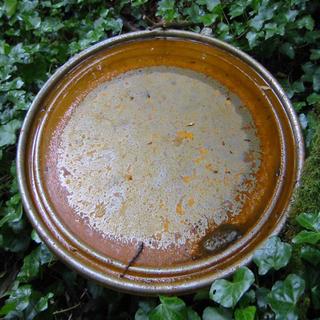
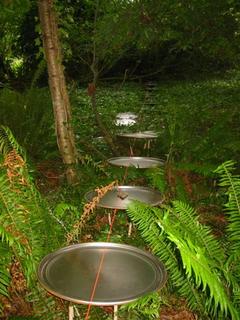

align is the first work approached in the wooded loop path portion of the installation. One comes upon it both suddenly and subtly: at the descending gentle incline on the trail, the work surfaces on the left, an oxidized punctuation in the green of the ivy groundcover.
This work is more about punctuation than sentence, to continue the literary metaphor. The work adorns the site, and directs it, these oil drum lids marking measured intervals from a subterranean starting point in a brushy undergrown spot farther up the hill to the bottom of a steep dropoff aiming toward the EPA site, formerly the Wycoff Creosote Plant.
The work is open to interpretation, but there are elements to note as fact: the oil drum lids were installed clean and bright and silver-colored in the landscape, completely level and strictly measured to step equally on center to the North. And over the duration of the exhibit, the work has encountered its own chaos: rain helping to oxidize the lids to a fiery rust, animals and wind shifting the horizontal lids off their bamboo stands, plants and people going over the line. This piece continues to reveal more of its message as it lives on in the space.
rbf Architects also worked as a team in the manner they conduct their architectural work, by consultation, contradiction, and supportive exchange. The result is a collaborative piece in the best sense of the word.
